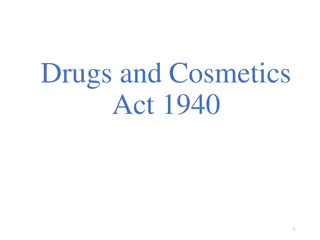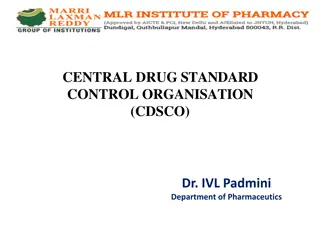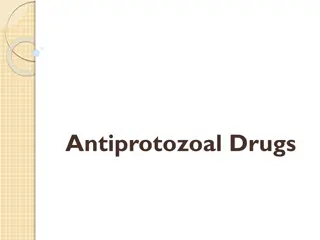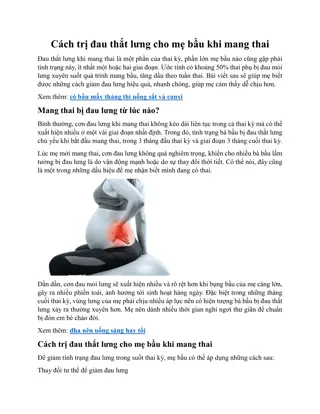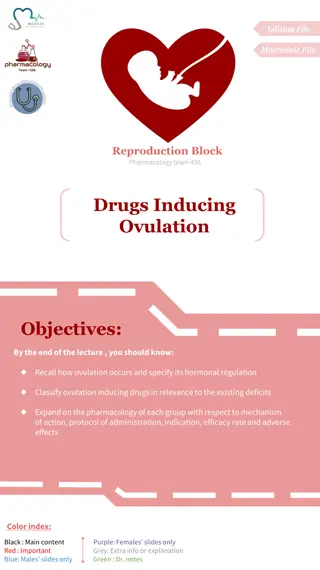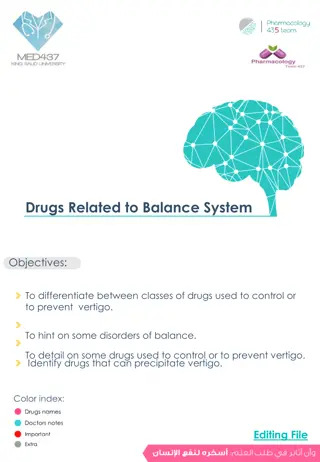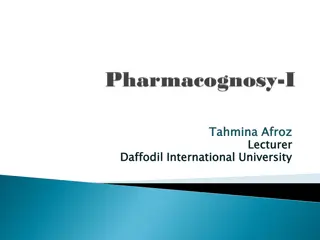Drugs that affect the Urrogenital System
Dr. Archana presents an insightful overview of drugs affecting the urrogenital system, including diuretics, urinary acidifiers, alkalizers, and their classifications. Diuretics are crucial in treating conditions such as edema, renal diseases, cirrhosis, and hypertension. The classification covers osmotic diuretics, carbonic anhydrase inhibitors, thiazide diuretics, potassium-sparing diuretics, aldosterone antagonists, and more. Explore the roles and indications of these drugs for optimal urogenital health.
Download Presentation

Please find below an Image/Link to download the presentation.
The content on the website is provided AS IS for your information and personal use only. It may not be sold, licensed, or shared on other websites without obtaining consent from the author.If you encounter any issues during the download, it is possible that the publisher has removed the file from their server.
You are allowed to download the files provided on this website for personal or commercial use, subject to the condition that they are used lawfully. All files are the property of their respective owners.
The content on the website is provided AS IS for your information and personal use only. It may not be sold, licensed, or shared on other websites without obtaining consent from the author.
E N D
Presentation Transcript
Drugs that affect the Drugs that affect the Urrogenital Urrogenital System System Presented by:- Dr.Archana Assistant Professor_cum_Jr.Scientist Deptt.Of Pharmacology & Toxicology Bihar Veterinary College, Patna
Drugs acting on Urogenital System Drugs acting on Urogenital System Diuretics Classification of Diuretics Urinary Acidifiers Urinary Alkalizes Urinary Antiseptics Fluid Therapy Ecbolics Tocolytics
Diuretics Diuretics These are drugs or agents that increase the volume of urine. Indications: (i) In the treatment of oedema due to cardiac failure. (ii) Renal disease (iii) Cirrhosis of the liver. (iv) In the treatment of hypertension
Classification of diuretics : Classification of diuretics :- - Osmotic Diuretics : Mannitol, Glycerol CarbonicAnhydrase Inhibitors : Acetazolamide , Methazolamide Thiazide Diuretics : Hydrochlorthiazide, Metolazone, Chlorthalidon Potassium Sparing Diuretics : Amiloride, Triamterene Aldosterone antagonist : Spironolactone, Canrenone Mercurial Diuretic : Calomel, Mersalyl Loop Diuretic (High Ceiling ): Furosemide Bumetanide, Ethacrynic Acid Xanthine derivatives : Theophylline, Aminophylline, Caffeine
URINARY ACIDIFIERS URINARY ACIDIFIERS Urinary acidifiers are drugs which cause acidification of urine. * They help in increased excretion of basic drugs * They enhance the antibacterial action of urinary antiseptics like hexamine and certain antibiotics (Penicillins and Tetracyclines). Eg- Sodium acid phosphate, Ascorbic acid, Methionine
URINARY ALKALIZERS URINARY ALKALIZERS Urinary Alkilizers are basic agents for alkalinization of urine. * Alkalinization of urine promotes antibacterial action of certain antibiotics (Aminoglycosides). * It helps in excretion of acidic drugs. * It increasing the solubility and reducing the risk of sulfonamide renal toxicity (crystalluria) especially in carnivores. Eg Sodium bicarbonate 3.
Urinary antiseptics Urinary antiseptics are oral agents that exert antibacterial activity in the urinary tract. * It has little or no systemic antibacterial effects. * It s usefulness is limited to lower urinary tract infections Eg Nitrofurantoin, Methenamine , Nalidixic acid, calcium Mandelate
Fluid therapy D. Fluid therapy consist of administration of isotonic fluids to correct body s fluid imbalance. Indication : Haemorrhage, Vascular shock, Anaemia, Haemolysis Different fluids used are : whole blood, Blood plasma Blood serum, Plasma Volume Expanders
Continue. Condition Electrolyte Solution 1.3% sodium bicarbonate in saline or 5% dextrose Mild acidosis Severe Acidosis 5 % sodium bicarbonate or Ringer s lactate Acidosis and Hyponatremia Ringer s lactate + sodium bicarbonate @5gm/litre Alkalosis & Hypokalemia Potassium acidifying solution Acidosis, Alkalosis, Dehydration, Loss of Electrolytes Balanced electrolyte solution
Ecbolics or Oxytocics An ecbolic is an agent which stimulates contraction in the uterus at term, esp. in the treatment of atonic or hypotonic parturient uterus. Ecbolics are used at term, usually when parturition has commenced. Their action is to increase the contractile activity of uterine muscle. E.g. Oxytocin, Ergot alkaloids, prostaglandins.
Tocolytics The drugs which relax or inhibit the smooth muscles of the gravid uterus are called as tocolytic agents or uterine spasmolytics or uterine relaxants. The tocolytics inhibit both the spontaneous and oxytocin induced contractions of the pregnant uterus. Their clinical applications include prevention of premature labour or to delay parturition for managemental convenience. E.G :- Isoxsuprine, Salbutamol, Terbutaline, Ritodrine and Orciprenaline etc.
Classification of drugs acting on the uterus Classification of drugs acting on the uterus A. Uterine stimulant:- 1. Posterior pituitary hormone Oxytocin 2. Ergot alkaloid- Ergometrine, Methylergometrine 3. Prostaglandins- PGE2, PGF2 4. Miscellaneous Quinine, Ethacridine B. Uterine relaxant:- 1.Adrenergic agonist- Salbutamol, Terbutaline, Ritodrine 2. Calcium channel blocker Nifedipine 3. Prostaglandin Synthesis inhibitors- Aspirin, Ibuprofen, other NSAIDS 4. Miscellaneous Progesterone, Ethyl alcohol Anticholinergics.




